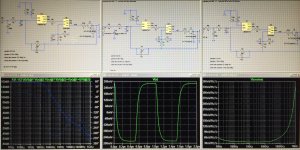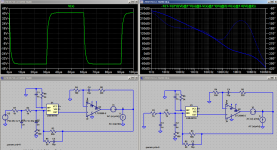Thought I would start a thread on this topic. The motivation is a preamp with over 20dB of signal gain and lots of output voltage capability that can be used to drive unity gain amplifiers (specifically for me a MoFo).
I'm not all that technically skilled in discrete circuits, or in general with circuit design, but I know some basics of design and have worked up op-amp circuits in the past. Also, I happen to already have a bunch of PCBs that I could use to try out the circuit before making a dedicated one.
The idea I have in mind is to have a 2-stage op-amp gain circuit: the first gain stage using a conventional audio op-amp (e.g. OPA132/OPA2132) for 10dB or so of gain and the second stage using a high-rail-voltage op-amp like the LTC6090 for the remainder of the gain, and for its ability to work with high rail voltages (Vrail,max=140V!). Separate "high" (> +/-24V) and "low" (< +/-18V) rails power the two stages.
I would jump in and simulate this immediately, but simultaneous SPICE modeling of circuits that use a combination of Linear and AD products doesn't seem possible because models are not easily transferable between simulators. If this is not the case, I would like to know how to do it, please!
Before I dive into working this up in two separate simulators, is this approach destined to fail because of one reason or another? Is the relatively low GBP of the 6090 a concern? Should most of the gain be achieved with the OPA2132? Is this just a bad way to go about making a gain stage, in general, or can this approach work well when appropriate design rules are followed?
I'm not all that technically skilled in discrete circuits, or in general with circuit design, but I know some basics of design and have worked up op-amp circuits in the past. Also, I happen to already have a bunch of PCBs that I could use to try out the circuit before making a dedicated one.
The idea I have in mind is to have a 2-stage op-amp gain circuit: the first gain stage using a conventional audio op-amp (e.g. OPA132/OPA2132) for 10dB or so of gain and the second stage using a high-rail-voltage op-amp like the LTC6090 for the remainder of the gain, and for its ability to work with high rail voltages (Vrail,max=140V!). Separate "high" (> +/-24V) and "low" (< +/-18V) rails power the two stages.
I would jump in and simulate this immediately, but simultaneous SPICE modeling of circuits that use a combination of Linear and AD products doesn't seem possible because models are not easily transferable between simulators. If this is not the case, I would like to know how to do it, please!
Before I dive into working this up in two separate simulators, is this approach destined to fail because of one reason or another? Is the relatively low GBP of the 6090 a concern? Should most of the gain be achieved with the OPA2132? Is this just a bad way to go about making a gain stage, in general, or can this approach work well when appropriate design rules are followed?
The idea I have in mind is to have a 2-stage op-amp gain circuit: the first gain stage using
a conventional audio op-amp (e.g. OPA132/OPA2132) for 10dB or so of gain and the
second stage using a high-rail-voltage op-amp like the LTC6090 for the remainder of the gain
Linear Tech is now part of ADI, so there should be a way to combine these parts in one simulation.
Check with ADI support. Welcome | EngineerZone
I would use the LTC6090 at a lower gain (but more than 1.2xVcc_high/Vcc_low), for both wider bandwidth
and lower output impedance.
Last edited:
CharlieLaub,
I built this preamp specifically with the MoFo in mind. It's 20dB, but doesn't use opamps. The performance with 6 actives exceeds an opamp though and output voltage currently is 40v p-p. It could be higher with a few adjustments in the LTP current.
AKSA's Lender Preamp with 40Vpp Output
I just tested it with a MoFo (sans inductor) this morning. Plenty of drive. THD of 0.002% is right up there with the best opamps.
Here is test with MoFo:
http://www.diyaudio.com/forums/pass-labs/313649-build-mofo-23.html#post5247923
The level of output of this pre allows me to drive the MoFo as loud as I want within limits of the MoFo and powersupply. It's quite transparent.
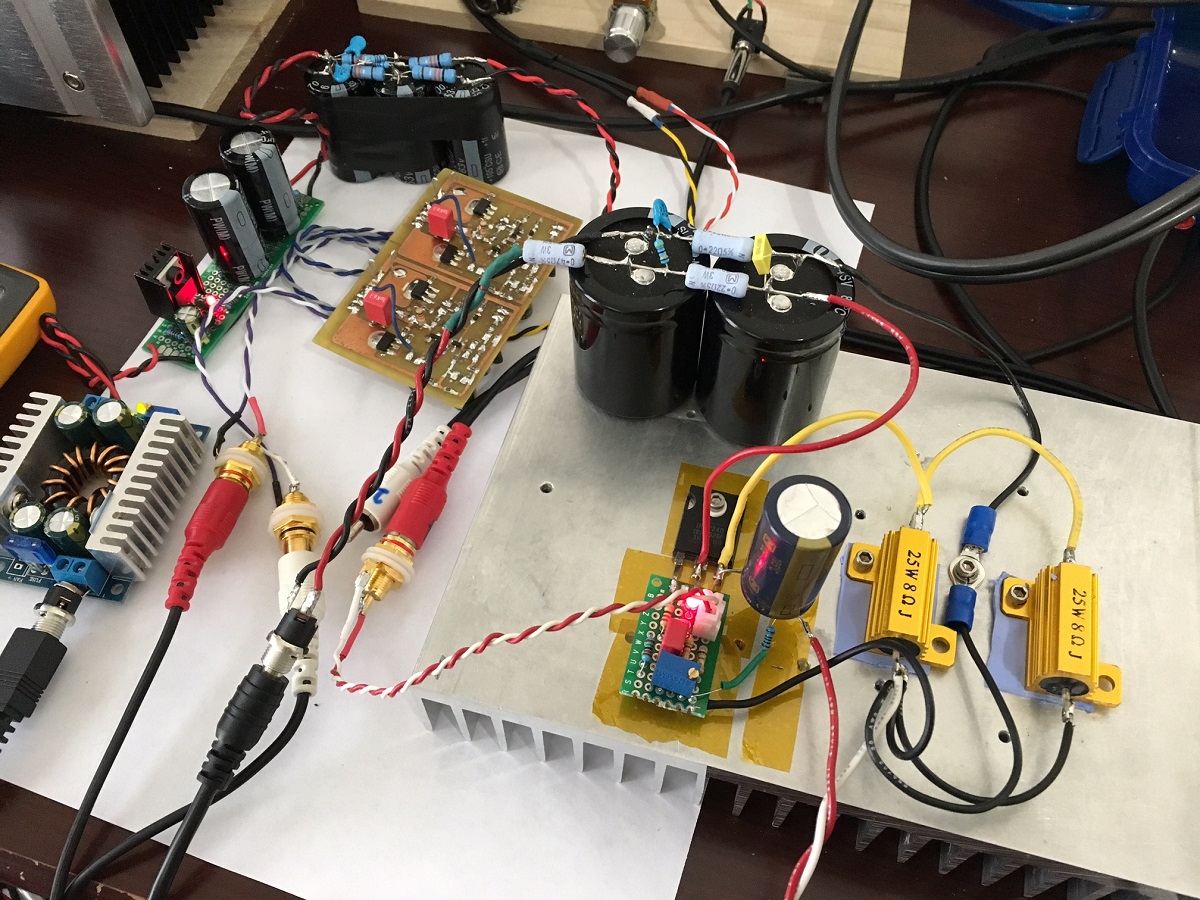
Here is the latest version of the preamp's measured performance at 20vpp with with 21dB gain. This is assuming a 7kohm load (MoFo is a much easier load at 200k):
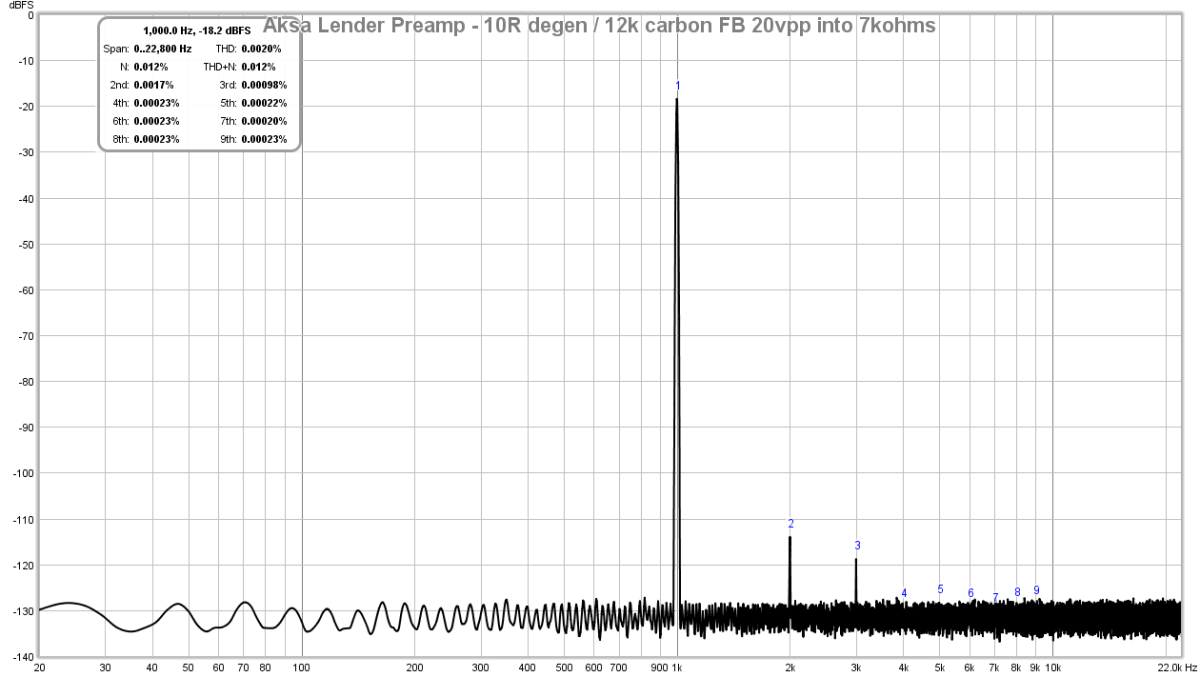
Here is the preamp, uses single 48v supply. I made it in SMT but JPS64 made a through hole PCB layout specifically for the MoFo already.
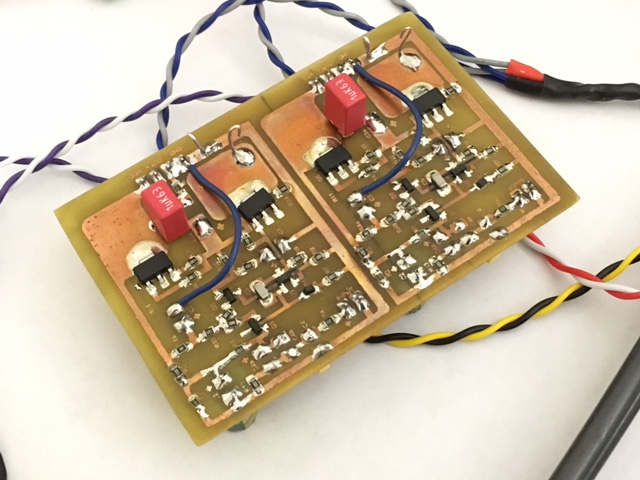
I think you saw this, but just putting it here for others who are still intent on using opamps to get HV swing, try bootstrapping an opamp with a 2N5401/2N5551:
Surjan Dogran's Easy Peasy 70v peak-peak Opamp for $1
Here is a quick veroboard proof of concept that was pushing 70vpp:
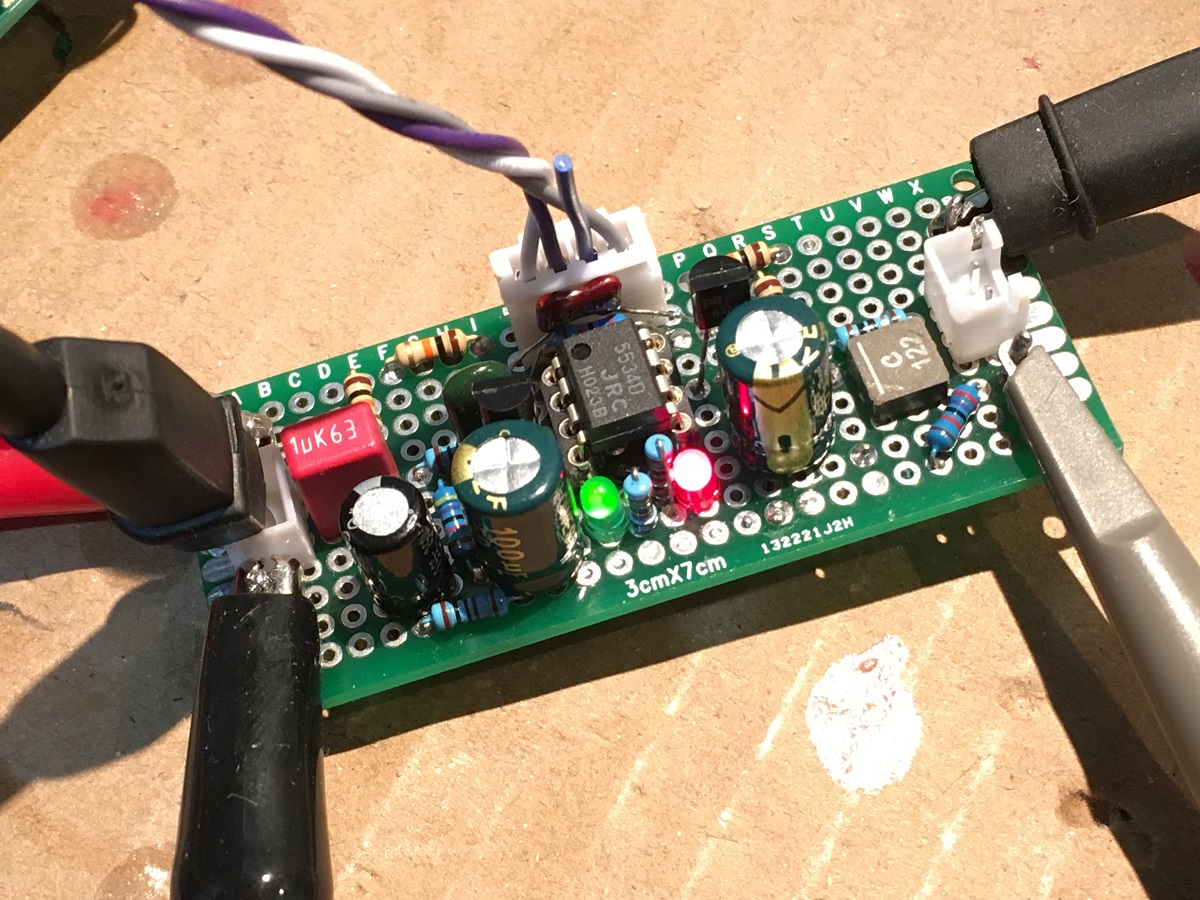
I built this preamp specifically with the MoFo in mind. It's 20dB, but doesn't use opamps. The performance with 6 actives exceeds an opamp though and output voltage currently is 40v p-p. It could be higher with a few adjustments in the LTP current.
AKSA's Lender Preamp with 40Vpp Output
I just tested it with a MoFo (sans inductor) this morning. Plenty of drive. THD of 0.002% is right up there with the best opamps.
Here is test with MoFo:
http://www.diyaudio.com/forums/pass-labs/313649-build-mofo-23.html#post5247923
The level of output of this pre allows me to drive the MoFo as loud as I want within limits of the MoFo and powersupply. It's quite transparent.
Here is the latest version of the preamp's measured performance at 20vpp with with 21dB gain. This is assuming a 7kohm load (MoFo is a much easier load at 200k):
Here is the preamp, uses single 48v supply. I made it in SMT but JPS64 made a through hole PCB layout specifically for the MoFo already.
I think you saw this, but just putting it here for others who are still intent on using opamps to get HV swing, try bootstrapping an opamp with a 2N5401/2N5551:
Surjan Dogran's Easy Peasy 70v peak-peak Opamp for $1
Here is a quick veroboard proof of concept that was pushing 70vpp:
Last edited:
If "high voltage" is only +/-24v, the opa604 has no problem with it. But it's not able of a rail to rail output, so you'll be limited at about 42vp-p
Bootstrap almost any opamp with two TO92's and four resistors to get 70v p-p.
Surjan Dogran's Easy Peasy 70v peak-peak Opamp for $1

Charlie, I think you'll find that LTSPICE will gladly simulate any of its presupplied LT opamp models, with higher-than-datasheet power supply voltages. That's not an error condition the software checks for. An LT1498 will run just fine from plus-and-minus 60 volt supplies, and swing its output over 100 volts --- in simulation.
But you don't even need to mess with that. You can simply find an LT part which is a reasonable equivalent to the OPA132 and drop it into your simulation. You'll simulate with LT and build with AD. Such as: the LT1022 is an FET input opamp whose GBW is 8.5 MHz and SR is 23 V/usec. The OPA132 is an FET input opamp with 8.0 MHz and 20 V/usec. Pretty close.
So go ahead and simulate the first stage using the LT1022. Drop in the LTC6090 for the second stage. Hook up their respective power supplies, connect up their feedback networks, and go to town.
Me, I'm a bandwidth lover so I would choose the gains of the two stages in such a way as to maximize the end-to-end bandwidth. Keeping in mind that the LTC6090's bandwidth is (12/8)ths as high as the OPA132's bandwidth. Oooh! A quadratic equation! Back to 9th grade algebra class!
But you don't even need to mess with that. You can simply find an LT part which is a reasonable equivalent to the OPA132 and drop it into your simulation. You'll simulate with LT and build with AD. Such as: the LT1022 is an FET input opamp whose GBW is 8.5 MHz and SR is 23 V/usec. The OPA132 is an FET input opamp with 8.0 MHz and 20 V/usec. Pretty close.
So go ahead and simulate the first stage using the LT1022. Drop in the LTC6090 for the second stage. Hook up their respective power supplies, connect up their feedback networks, and go to town.
Me, I'm a bandwidth lover so I would choose the gains of the two stages in such a way as to maximize the end-to-end bandwidth. Keeping in mind that the LTC6090's bandwidth is (12/8)ths as high as the OPA132's bandwidth. Oooh! A quadratic equation! Back to 9th grade algebra class!
- G_overall = G_opa * G_ltc
- G_overall = G_opa * (1.50 * G_opa)
- G_overall = 1.50 * (G_opa squared)
- G_opa = square_root(G_overall / 1.50)
- G_ltc = 1.50 * G_opa
I have been following the thread on you lender preamp project with interest. In the meantime I am thinking about other options I could do and that lie within my "comfort zone". A 2-stage op-amp preamp is something I can build up using PCBs and parts that I already have lying around - I just need to buy the op-amps.
I came on the 2-op-amp gain stage approach via the the bootstrapped approach, where I found myself asking why I would need to bootstrap if I could just find an op-amp that could handle higher rail voltages. This led me to the LT6090. Anyway, because of some of the pitfalls of bootstrapping if I do not use the 2-stage approach I will just try your circuit once it has had a little more proving time.
I came on the 2-op-amp gain stage approach via the the bootstrapped approach, where I found myself asking why I would need to bootstrap if I could just find an op-amp that could handle higher rail voltages. This led me to the LT6090. Anyway, because of some of the pitfalls of bootstrapping if I do not use the 2-stage approach I will just try your circuit once it has had a little more proving time.
Hi Mark,
Thanks for the advice on the modeling approach. I will download LTSPICE and give that a try. For some reason I imagined a higher value for the GBP of the OPA132 - it's actually LESS than the LTC6090. Thanks for bringing that to my attention.
Thanks for the advice on the modeling approach. I will download LTSPICE and give that a try. For some reason I imagined a higher value for the GBP of the OPA132 - it's actually LESS than the LTC6090. Thanks for bringing that to my attention.
Is 20+dB in one stage not a bit too much?Why don't you go first at 20dB with just the LTC6090 to see what you get.
Then, if a best thd is your concern you can go at gain 3 with the LTC6090 and you will have plenty of op amps you can use in front of it.
Last edited:
I have been following the thread on you lender preamp project with interest. In the meantime I am thinking about other options I could do and that lie within my "comfort zone". A 2-stage op-amp preamp is something I can build up using PCBs and parts that I already have lying around - I just need to buy the op-amps.
I came on the 2-op-amp gain stage approach via the the bootstrapped approach, where I found myself asking why I would need to bootstrap if I could just find an op-amp that could handle higher rail voltages. This led me to the LT6090. Anyway, because of some of the pitfalls of bootstrapping if I do not use the 2-stage approach I will just try your circuit once it has had a little more proving time.
I agree that if you can use a HV opamp, go for it. Btw, the MoFo is dead quiet with the Aksa Lender preamp. I can connect headphones and use as a headphone amp and the sound is gorgeous. Here is 2vpp into 8ohmms dummy load and headphone is connected in parallel with dummy load.
Cool. I have 5532 & 2n5401/5551 in the stock bins. High voltage op amps are not typically stocked at my goto supply, & I've been monkeying around with LM1875 (which is not stable under gain 10) and LM49810 (which has pins too close together to solder without a purpose made board) I have DIP project boards that solder very nicely.
Who needs opamps anyways when 6 transistors can swing 70vpp into 10kohms with this kind of profile? (100v single supply rail, 20dB gain)
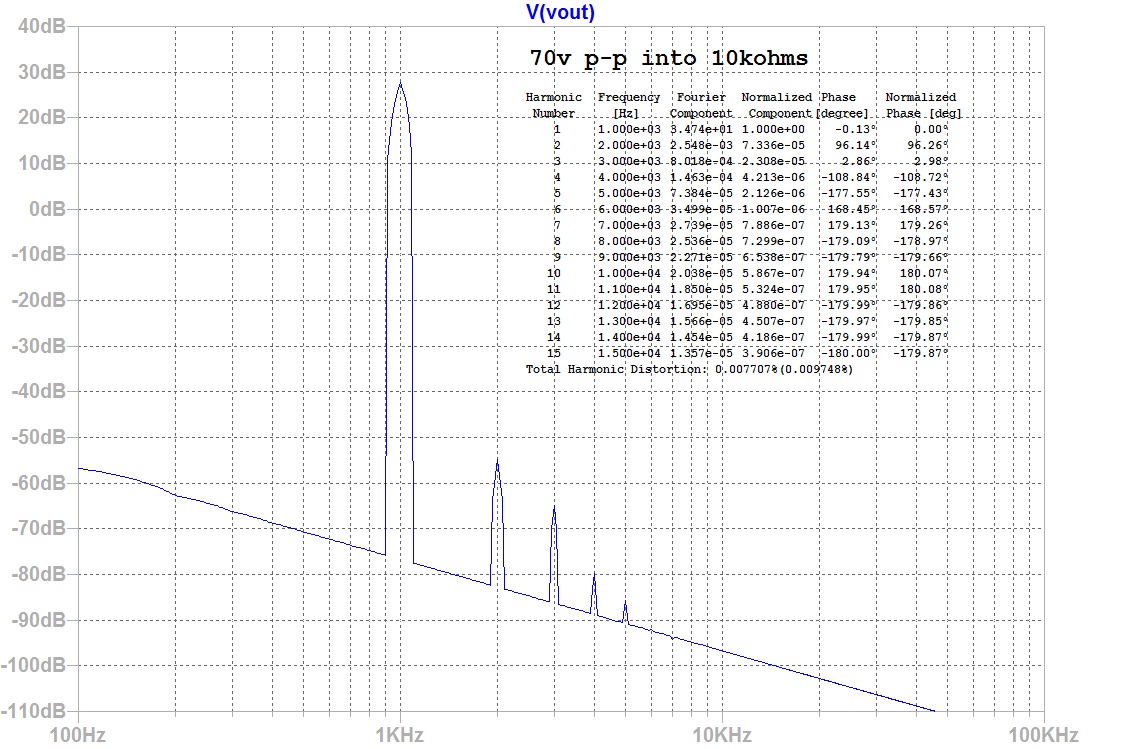
More here (change out inputs for MMBT5401, change a few resistance values, make Vcc 100v):
http://www.diyaudio.com/forums/soli...ender-preamp-40vpp-output-16.html#post5248794
More here (change out inputs for MMBT5401, change a few resistance values, make Vcc 100v):
http://www.diyaudio.com/forums/soli...ender-preamp-40vpp-output-16.html#post5248794
Last edited:
Do you need help with arrangement like this:
View attachment 646635
It's very hard to see due to poor photo quality and screen raster bit/fringe interference. Please use CTRL + Print Screen to capture your screen to a bitmap. Then save in "Paint" or other graphic program and upload as JPG or PNG file.
Within your sim program, there is usually a screen bitmap capture function. I know LTSpice has it and so does TINA.
Thanks,
X
It's very hard to see
Excuse me for my laziness.
http://www.diyaudio.com/forums/pass-labs/299645-common-emitter-ops-5.html#post5010335
Most of the info in graphs for easy of understanding, entirely nominals will be different, so there are only main idea.
First opamp doesn’t have local feedback.
- Status
- This old topic is closed. If you want to reopen this topic, contact a moderator using the "Report Post" button.
- Home
- Source & Line
- Analog Line Level
- op-amp based, high-gain, high rail voltage, preamp
